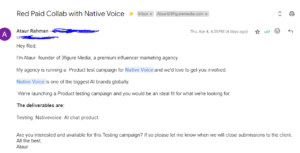Influencer marketing is like the Wild West. I will break down for you a step-by-step guide to running an effective influencer marketing campaign
How to Run an Influencer Marketing Campaign
Step 1: Define your objectives, strategy, and budget for influencer campaign
The first step in running an influencer campaign is to define your objectives, strategy, and budget for your influencer campaign.
What are you looking to do? Is this a campaign where you’re trying to drive sales to a product? Is it a campaign where you’re trying to get leads for a mailing list?
Because the strategy that you go down changes completely based on what you’re trying to achieve. It’s also super important to decide what you will spend on influencers and how you will price the influencers in the campaign.
Let’s say you’re a brand and looking to achieve 1 million views in a campaign, and you know you can spend $20 to achieve 1,000 views. That means if you spend $220,000, you’re going to be able to achieve that 1 million views.
If you’re a brand that can spend $50 to acquire a customer, then you spend $220,000. That means that you know to break even, you need to get 400 sales. So, you’ve outlined your objectives, you know that you either want to achieve this many sales, you want to get this many people to your lead list, or you want to get this many impressions, and you’ve decided that you guys are willing to spend this amount of money. And we know how much we need to get from this amount of money.
Step 2: Define your creative direction.
Influencer marketing is such that you can’t do this old, typical, mundane type of ad, right? Because people’s attention spans are so low. TikTok has killed everyone’s attention span. So, you now need to find creative and exciting ways to engage your audience when you’re doing an ad.
No one wants to see a forced ad from anyone. Could you set up a challenge where the audience has to partake in some sort of action and they can win something? Or could you do a giveaway? Or could you get influencers to do something specific within the content? You know, it’s thinking about the various creative ideas.
Some of the things that we’ve done in the past have been completely off-script, and off-brand, but they’ve worked the best. You want to make the ad look least like an ad. That is what’s going to perform well, especially on things like TikTok.
One of the best ways to define creativity is by talking to influencers. When you assess who you want to potentially work with, collaborate with those influencers to understand maybe what their audience is like to see.
You know, have a specific content series that they do, and their audience might want to get involved in that content series.
Step three: Know your target audience
Most brands think they know their target audience, but they don’t, and this is a super important step. If you are a brand that’s focused on a male-leaning audience, we’re not going to promote via female influencers with a high female audience.
It just doesn’t make sense. So, you need to understand who your target audience is because then that ties into the influencers and the strategy that you’re going to use. If you’re a gaming brand, you’re probably going to want to partner with a gamer who has an audience of gamers.
It’s pretty simple, but it’s something that brands seem to forget, and they just get lost in the vanity metrics and the followers, and they think this creator with 1 million followers is going to be better than this creator with 10,000 followers.
But if this creator with 10,000 followers has a more hyper-targeted audience within your target audience, it makes far more sense to go down there.
Step 4: Identifying the influencers for the influencer Campaign
How do you identify influencers for a campaign? There are multiple different ways, some are more manual than others. If you don’t have a huge budget to spend on influencer marketing platforms or data services, you can just go down the most manual route.
Head on YouTube, head on TikTok, head on Instagram, and search for hashtags or keywords within what you’re trying to do. So, if you’re a fitness brand, search for fitness influencers.
Or if you’re a sports brand, search for footballers. Or if you’re trying to promote a product that is relevant to the FPL, then maybe look at Fantasy Premier League footballers.
There are so many different ways you can do that, but hashtags are heavily underutilized by brands, and you’re able to find so many influencers that you want to work with through there. That’s a very manual and tedious process though.
If creators don’t have a high engagement rate, we don’t want to work with them because it means that their audience probably won’t engage with our ads.
And also, we need to look at influencer fraud analysis as well because a lot of influencers have issues where they have bots or they maybe have purchased followers before. We don’t want to be promoting our product to a bunch of bot followers.
Now, we have identified our influencers. What you typically should do is you should put them in a spreadsheet and get all the important bits of information on the influencers. So, name, contact information, maybe some personalization on them, you know why they’ll be a good fit for the campaign, and kind of get this listed out. Now we want to go and reach out to the influencers.
Step 5: Establishing relationships with the content creators and reaching out to them.
The best way to reach out to influencers is always via email. Everyone thinks, “Oh, their influencers, they won’t check their emails,” but they have dedicated business emails for a reason.
That’s where they want to receive business opportunities. They don’t want you to be coming at them in their comments, they don’t want you to be coming at them through DMs unless you know them well. Go via their emails. So, you want to go and get their email information. Typically, this will be in their bio, or on YouTube, it might be in their About section, you can click for business inquiries. And you just need to go and just drop them an email.
And how you should structure the email is pretty simple.

Let’s say we’re doing the brand Campaign and it’s an AI chat Product brand. You might put “Paid Collab with Brand Name”
or something like that. Very simple.
You just want to get across that it’s a paid campaign. Introduce yourself, personalize a little bit, you know tell them that maybe you watched a video a few days back and you really like this part.
You want to make it personal so the creator thinks that you’re interested in their content and you’re putting a bit of effort into watching them and understanding why they could be a good fit for the campaign.
So, you want to get information around what the campaign is, and what you’re expecting them to do from a deliverable standpoint. You know we might be saying we’re trying to if we’re trying to achieve a million views on YouTube I might want them to do 60 integrations.
That’s a very standard YouTube influencer marketing route.
Trying to get 60 integrations. This is the timeline and this is the fee.
And how you would typically calculate the fee is based on what we looked at before.
We’ve identified the CPM for this campaign which was $20, and we’re basing it on their average views. You can calculate their average views very simply by adding up their last 10-12 videos and dividing by the number.
You get their average views, and you can offer them an amount based on their average views because we can assume they’re going to hit that amount in this video.
A lot of the time when you are trying to build a relationship and outreach to creators, you will have to do follow-ups because sometimes creators just get very busy, they’ll miss their emails.
After about three or four follow-ups, just assume they’re not interested at this time and move on to the next creator. Once that’s done, you want to move over to get their contact details for a more personal platform.
WhatsApp is the best one for us. We usually try to take all the creators to WhatsApp. It means it’s quicker communication. You’re breaking the fourth wall, you don’t have to go via emails anymore which are a bit more formal, and you can just be much quicker with communication with the creators. You want to build a long-term relationship with creators.
Step 6:Getting contracts from influencer
One of the most important steps is getting contracts in place. People are flaky, that might not be the best word for it, but that’s just how it is. There are numerous times that we agree on something with the creator and they just go back on their word, or they might drop out or something comes up.
You need to get a contract in place because otherwise there’s nothing legally binding the creator to deliver the results for your campaign. Contracts can be very simple, just going over the terms of the campaign, the compensation, the deliverables, the timelines, when things need to be done, when they need to send you content and drafts, and any other provisions like exclusivity or usage rights.
But make sure you get everything in a contract because that means that creators have this sort of feel of a legal binding to working with you in the campaign. And at the end of the day, it’s a legal contract.
step 7: Getting the content live
You have all the creators, you’ve got the contracts, and now it’s time to start getting them to create the actual content for the campaign. Now at this point, you need to work with the creators very closely allowing them creative freedom because they know their audience best, and they know their content best, but making sure that they cover the important parts of your brief, getting them to create the content around what your objectives are within the campaign is super important with their creative spin and the creative direction that you guys took earlier on in the campaign process.
And then set clear expectations with the creator which should have already been in the contract of when the content needs to go live. At this point, it’s super important to make sure you check the content that’s gone live and ensure that they’ve included all the tracking links and anything that you need in the descriptions or bios. Otherwise, there’s no way to track the results of the campaign.
step 8: Monitoring and measuring
Monitoring and measuring. This is super important because how do you know how the campaign performed if you don’t monitor and measure the results?
So, you can use multiple different tools for this. But again, if you don’t have the funds or you don’t have an influencer platform, you can do this all manually. Set up a spreadsheet, and all you have to do is plug in all the numbers,
pull in all the data, run a few formulas and calculations, and you’ll be able to see what creators have performed. You can run CPM numbers in here, costs, there’s a whole bunch of things you can measure and monitor. You need to make sure that you’re setting up your measurement related to your campaign objectives and goals.
The second last step is Influencer Marketing campaign analysis and optimization.
You now have your campaigns live, you have your measured data. You want to compare how the content performed against your initial objectives. Look at what worked, and what didn’t. Maybe this creator did well, this creator didn’t do as well as you thought.
And then you want to take the good parts of the campaign and allow you to sort of optimize for the future, refine your strategy, and double down on what worked. Ultimately at this point, what we’re aiming for is to see that the campaign that we have run has greater results than what we initially had at the outset.
And again, you can do this in platforms where you can put reports through from the metrics that have been filmed. And if it doesn’t, that’s fine. Campaigns don’t always go well, but if you set up the campaign correctly, it should go as you want and you should generally over-deliver if you ensure that you’re paying creators the correct amounts and you’re hitting your sort of cost metrics and keeping an oversight of your campaign at all times.
The final step that everyone forgets about is continuing to nurture the relationship with the creators when the campaign is over. That doesn’t mean you just stop contact with the creators, doesn’t mean you just bend them off essentially.
So, that’s it. That’s how you run an influencer marketing campaign in 10 simple steps. And if you make sure that you follow all 10 of these steps correctly and you’re watching every single stage of the campaign process, you’re going to have an effective influencer marketing campaign and you’re going to be able to run many effective influencer marketing campaigns going forward. I

